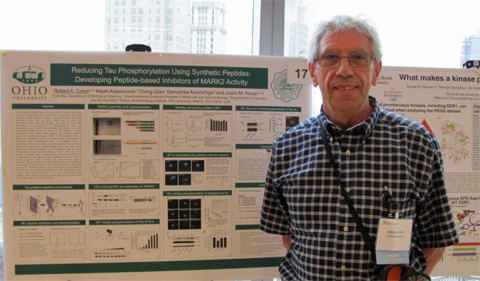By Lori Price
Biomimicry is a humanistic concept centered around looking to nature for inspiration in terms of both form and function, according to Dr. Justin Holub. It is applied in many different ways. It shows up in engineering as natural forms are incorporated into car, plane and train designs to enable them to move more efficiently. We see biomimicry in artwork, where natural forms are imitated to convey the artist’s vision, and we see it in architecture in the guise of buildings, hexagonal domes and even tent design.
Holub, Assistant Professor of Chemistry & Biochemistry, spoke on “Biomimicry as a Modern Movement” in his Fall 2014 Science Café presentation at Ohio University. He specializes in chemical biology, biochemistry, medicinal chemistry and synthetic biology.
This mimicry may take place on a macro scale, such as mountains, or on a micro scale, like the toes on a gecko lizard. However, Holub works on an even smaller level. His research focuses on using biomimicry at the molecular and even nano level to generate small molecules and proteins that mimic natural ones.
He defined biomimicry as “the imitation of models, systems or elements of nature for the purpose of solving complex human problems.” Holub explained that the rationale for biomimicry operates on the principle that nature has a head start on solving problems, that nature has had a very long time to find practical solutions to basic and complex problems.
Leonardo da Vinci: Father of Biomimicry
Looking closely to see how nature has solved a particular problem may enable us to skip enormous amounts of trial and error and guide us to the solution that works best and most easily. “Through the processes of natural selection and adaptation, nature presents a wide array of design lessons, if we look to the overarching patterns found amongst species that are surviving and thriving,” according to Holub. He added that natural design is often very resource efficient.
Holub believes that all life on earth is interconnected in a very concrete, physical way. “We are all subject to gravity, atmospheric pressure, weathering, and interaction with other substances. All life has to function under similar operating conditions. Therefore, natural life has developed many specific strategies in reaction to our shared environment that create conditions conducive to life. By studying and learning from these natural design lessons, we can model innovative strategies of nature’s success.”
According to Houb, Leonardo da Vinci was the historic father of biomimicry, known for his many inventions that looked to nature for the initial design and incorporated natural structures to solve functional problems. The example he presented was the way in which da Vinci started with the bat to visualize a type of flying machine. Holub referred to this as the first documented attempt at biomimicry and discussed how the design went through many revisions to ultimately arrive at the form of the modern jet airplane.
The more contemporary forefather of biomimicry is Otto Herbert Schmitt (1913-1998), Holub said. He was an academician and an electrician who experimented with electrical phenomena, bioengineering and biophysics and is noted as the person who coined the term, biomimetics, in his graduate thesis. He invented the Schmitt Trigger to improve electrical pulse conduction based on his studies of nerve impulse propagation in squid.
From Molecules to Velcro, Micro to Macro
Holub went on to explain the order and organizational levels of biomimicry, which at the macro level include the organism, the environment and the ecosystem. He pointed out that a fourth level would be at the molecular level, which is his area of focus.
He gave several examples of innovations based on biomimicry at the macro level, such as how burdock plant burrs were studied to determine what caused them to stick to other things so well, and that design was adapted to create the well-known product, Velcro. He also discussed how the use of the electron microscope allowed researchers to study the toes of geckos to understand how they are able to cling to smooth surfaces in a seemingly gravity-defying manner. Microscopy enabled researchers to see that the minute, spatulate tips on the tiny setae hairs on the geckos’ toes enabled them to cling to smooth surfaces so well. These studies have resulted in the invention of Gecko Grip Tape, a product that holds tightly to very smooth surfaces.
Holub went on to detail how lotus petals were studied for insight into wetting forces and have yielded important hydrophobic coatings and how the study of the tiny denticle scales of the Mako shark have been studied to learn new ways to reduce drag in the water, which resulted in the development of new wetsuits and boat hulls that allowed faster movement through the water. The pectoral fins of the Humpback whale have been studied, resulting in innovations in the design of turbine blades and airplane wings. Termite mounds have also been examined and resulted in new information regarding how to reduce the energy consumption for cooling buildings by 90 percent, making them very energy efficient.
Biomimicry is also being used at the molecular level to guide important innovations. Holub explained that his work has focused on creating synthetic versions of natural substances. However, it is important that created products hold to certain standards; the creations have to look like the natural inspiration, be made of the same material and in the same way, that the process must work in the same way and that the created molecule must function like the natural substance.
Bee Venom, Spider Silk, Scorpion Venom
Examples of research in this area include the study of bee venom, which has been shown to have healing properties. According to current studies, these molecules can form pores inside vesicles which contribute to antimicrobial action and may even have anticancer properties. Another natural substance, spider silk, one of the strongest substances known in nature, is being studied for possible use for encapsulating drugs and embedding peptides within the encapsulation that would seek cancer cells specifically to enable targeted delivery of drugs to those cells.
In Holub’s lab, the neurotoxins in scorpion venom are being studied. He wants to use biomimetically produced proteins to bind onto the surface of cellular mitochondria and to study the interaction of proteins to further the understanding of how several complex disease processes work. He is focused on mimicking protein functions. He is working with long-chain molecules or amino acid sequences, which form helices and other complex architectures when long enough. Since their structure dictates their function, Holub has worked to mimic certain proteins which fold into stable 3-D structures that have specific functions. His intention is to use biomimicry to study natural protein structures and evaluate their binding efficiency. Ultimately such information could affect the ways certain diseases are treated and possibly reduce their impact.
Holub said, “Recent developments in imaging equipment have revolutionized the field of biomimicry, as they have allowed a more detailed view of natural structures that goes beyond the cellular level to the molecular one, allowing researchers a deeper appreciation of the natural world. We may need to rework many modern designs as new nature-based information comes to light, to improve efficiency and effectiveness. Biomimicry is becoming a philosophy in addition to a science. We are able to apply this knowledge to everything from molecules to business models as we explore how nature solves complex design problems.”



















Comments